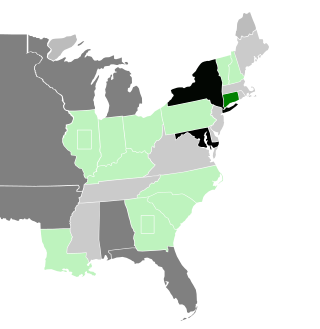On January 1, 1818, [1] a special election was held in North Carolina's 7th district to fill a vacancy left by the death of Representative-elect Alexander McMillan (F) before the 15th Congress had assembled. [2]
| Elections in North Carolina |
|---|
 |
On January 1, 1818, [1] a special election was held in North Carolina's 7th district to fill a vacancy left by the death of Representative-elect Alexander McMillan (F) before the 15th Congress had assembled. [2]
| Candidate | Party | Votes [1] | Percent |
|---|---|---|---|
| James Stewart | Federalist | 1,719 | 40.6% |
| John Culpepper | Federalist | 1,562 | 36.9% |
| Atlas Jones | Federalist | 767 | 18.1% |
| James Gaines | [3] | 137 | 3.2% |
| Joseph Winslow | Federalist | 53 | 1.3% |
Stewart took his seat on January 26 [4]

The 1822–23 United States House of Representatives elections were held on various dates in various states between July 1, 1822, and August 14, 1823. Each state set its own date for its elections to the House of Representatives before the first session of the 18th United States Congress convened on December 1, 1823. They occurred during President James Monroe's second term.
The 1820–21 United States House of Representatives elections were held on various dates in various states between July 3, 1820, and August 10, 1821. Each state set its own date for its elections to the House of Representatives before the first session of the 17th United States Congress convened on December 3, 1821. They coincided with President James Monroe winning reelection unopposed.
The 1818–19 United States House of Representatives elections were held on various dates in various states between April 26, 1818 and August 12, 1819. Each state set its own date for its elections to the House of Representatives before the first session of the 16th United States Congress convened on December 6, 1819. They occurred during President James Monroe's first term. Also, newly admitted Alabama elected its first representatives in September 1819, increasing the size of the House to 186 seats.
The 1816–17 United States House of Representatives elections were held on various dates in various states between April 30, 1816 and August 14, 1817. Each state set its own date for its elections to the House of Representatives before the first session of the 15th United States Congress convened on December 1, 1817. The size of the House increased to 184 after Indiana and Mississippi achieved statehood.
The 1814–15 United States House of Representatives elections were held on various dates in various states between April 26, 1814, and August 10, 1815. Each state set its own date for its elections to the House of Representatives before the first session of the 14th United States Congress convened on December 4, 1815. They occurred during President James Madison's second term. Elections were held for all 182 seats, representing 18 states.

The 1810–11 United States House of Representatives elections were held on various dates in various states between April 24, 1810, and August 2, 1811. Each state set its own date for its elections to the House of Representatives before the first session of the 12th United States Congress convened on November 4, 1811. They occurred during President James Madison's first term. Elections were held for all 142 seats, representing 17 states.

The 1808–09 United States House of Representatives elections were held on various dates in various states between April 26, 1808, and May 5, 1809. Each state set its own date for its elections to the House of Representatives before the first session of the 11th United States Congress convened on May 22, 1809. They coincided with James Madison being elected as president. Elections were held for all 142 seats, representing 17 states.

The 1818–19 United States Senate elections were held on various dates in various states. As these U.S. Senate elections were prior to the ratification of the Seventeenth Amendment in 1913, senators were chosen by state legislatures. Senators were elected over a wide range of time throughout 1818 and 1819, and a seat may have been filled months late or remained vacant due to legislative deadlock. In these elections, terms were up for the senators in Class 3.

In 1818, Uriel Holmes (F) of Connecticut's at-large district resigned from the House. A special election was held to fill the resulting vacancy.

In the 1816 elections in Pennsylvania, David Scott (DR) won one of the two seats in the 10th district, but resigned before the 15th Congress began, having been appointed judge of the court of common pleas. A special election was held on October 14, 1817 to fill the resulting vacancy.

During the 15th Congress, there were two special elections in the 6th district of Pennsylvania, both held in the year 1818. The 6th district at that time was a plural district with two seats, both of which became vacant at different times in 1818. The first vacancy was caused by John Ross (DR) resigning on February 24, 1818 and the second was caused by Samuel D. Ingham (DR) resigning July 6.

On April 20, 1818, Jacob Spangler (DR) resigned from Congress, where he'd represented Pennsylvania's 4th district. A special election was held that year to fill the resulting vacancy.

On November 7, 1818, a special election was held in North Carolina's 11th district to fill a vacancy caused by Daniel M. Forney (DR)'s resignation earlier that year.

On February 21, 1818, Representative Peterson Goodwyn (DR) of Virginia's 19th district died in office. A special election was held to fill the resulting vacancy.

On April 20, 1818, Thomas B. Robertson (DR) of Louisiana's at-large district resigned. A special election was held to fill the resulting vacancy.

Mississippi was admitted as a state on December 10, 1817 from the western half of the former Mississippi Territory. It elected its first representative to Congress August 4–5, 1817.

On November 3, 1817, John C. Calhoun (DR) of South Carolina's 6th district resigned upon being appointed Secretary of War. A special election was held for his replacement

Illinois elected its new member sometime in 1818, after gaining statehood.
A special election was held in Massachusetts's 20th congressional district on March 16, 1818 to fill a vacancy left by the resignation of Albion K. Parris (DR) on February 3, 1818 after being named a judge of the United States District Court for the District of Maine.

John Condit (Democratic-Republican) of New Jersey's at-large congressional district resigned to become assistant collector of the Port of New York.